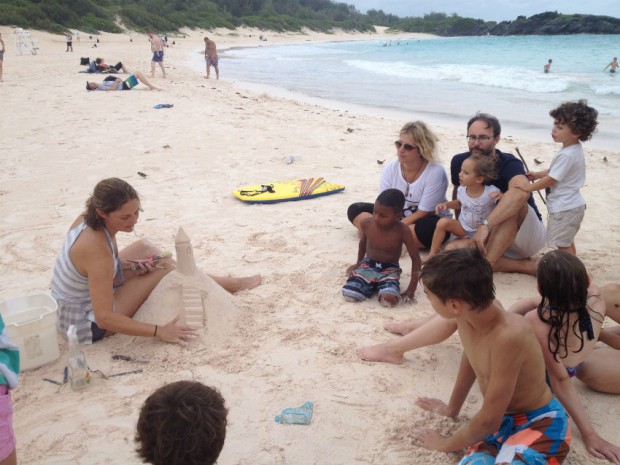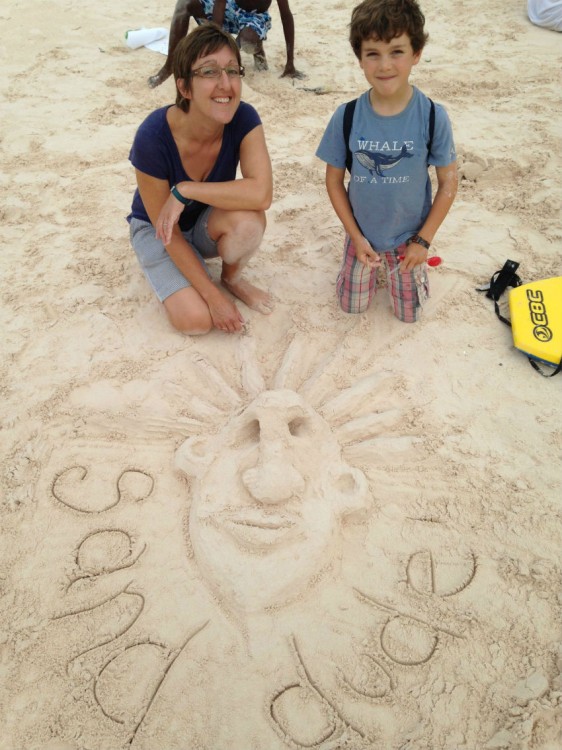Sandcastle Workshop To Be Held This Evening
With the 19th annual Bermuda Sand Sculpture Competition set to take place on August 30, 2014 at Horseshoe Bay Beach from 10.00am to 4.00pm, many aspiring participants are taking the time to perfect their sandcastle crafting skills via workshops offered by Hannah Strang, a participant and winner in several previous competitions.
The workshop, held on Saturday [Aug 23], was the first of two sessions planned to be held, with the second one postponed until tonight [Aug 25] at 6.00pm at Horseshoe Bay Beach.
Using the skills she’s learned over time as a crafter of sand sculptures, Ms. Strang has been passing her knowledge onto those who would like to improve their own skills in advance of the competition, with the process beginning with a set of guidelines intended to help sculptors nail down the basics of working with sand.
Regarding the tools of the trade, Ms. Strang’s “Sandcastles 101″ information sheet [PDF sheet] says, “Buckets are number one – the bigger the better! Water is the most important thing about a sandcastle; it is the thing that makes it stay together, and you will need lots of it.
“The bigger the bucket the better but keep in mind that they are really heavy when full. You still want to be able to carry them up the beach.
“Shovels are also handy when making large forms but keep in mind you will be shoveling wet sand as well as dry and to go easy on your back.”
“Carving tools can be made from anything and everything. Something as simple as plastic knives and forks work well [please take all trash with you]. Simple everyday household items like chopsticks or a trowel can work well too.
“If you really want to get fancy though, painters palette knives make sharp edges easy, large soft paint brushes create smooth surfaces, and a straw is a must-have to blow the sand away as you carve out fine detail.
“A spray bottle with water is also a good idea for keeping working surfaces wet.”
Regarding design, the information sheet says, “Just because everyone else does, doesn’t mean you have to create a castle out of sand. Your ideas are only limited by your imagination. Other popular options are of course mermaids, sharks, whales, and other seaside themes.”
“But every now and then dare to be different. The only side notes I will make to this are; when entering a contest judges like to see a story. What is your mermaid doing? Is your shark about to eat a fish? Add humor when you can. Secondly Bermuda sand will not hold heavy undercutting, large arches, or freestanding arms etc.
“The sand in the USA has more clay in it and so can support more fancy designs. Keep this in mind when you are planning. You will spend hours trying to get your mermaids hand to point or her nose and chin to stay on and you won’t win against gravity.
“Water is key to this first step. Dry sand is no good and a mound of dry sand will never absorb water no matter how many buckets you pour on it, the water will just run down the sides. Sand must be piled up layer by layer by heaping hand fulls of wet sand.”
“For really big shapes you can start with a wide base and slowly layer up around the edges building a volcano and pouring the water into the center so that it is forced to flow through your sculpture. The harder and wetter your sand the easier it will be to carve and the less likely it will be to crumble.
“I suggest drawing an outline of where your sculpture is going to sit. If you are doing a person for instance, have a friend lie down and draw around them. Then start building the sand up inside your lines to the rough height and shape you need. Pat and pack the sand tight and keep pouring on the water until your shape is hard and smooth. Now you are ready to carve.
“Start to cut away at your mounds and shape them into your sculptures arms, legs, turrets, or towers. At this point I recommend taking time to walk around and look at your piece in progress. That tower you just spent the last hour perfecting actually leans away from you when you look at it from the other side.
“This becomes important if you want to keep things in proportion.”
“Always work your details from the top down so that the sand you cut away doesn’t fall on the details below and cover it.
“Lettering, windows and doors, should be sketched out lightly and cut away with a sharp metal object like a pallet knife. Straws can be used to blow the sand you are carving out of corners and crevices.
“Tunnels can be made by carefully packing sand until it is rock hard. Then slowly cutting an arch into it. If you can, go from both sides and work towards meeting in the middle. Be very careful how thin you make your tunnels. Always remember gravity.
“Cracks are never fun and always scary. They can often be fixed by adding water and gently patting some very wet sand on top, then adding more water to cement it in place. Prayer works here too.”
“Textures can also play a huge role in adding life to your sculpture. Soft, smooth surfaces can be made with a wide house painters brush. Often a rake can be used to add rough lines or even out a surrounding area. The contrast of a smooth surface next to a rough surface can really pop your sculpture.
“Make sand balls the same way you would snow balls and add them to the tops of walls or towers.
“To make stairs, simply smooth the surface you want to create and start at the top making 90 degree cuts down half an inch and then across half an inch, then down again and continue until you reach the bottom.”
Read More About
Category: All, Entertainment







